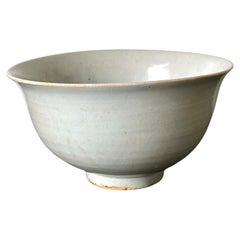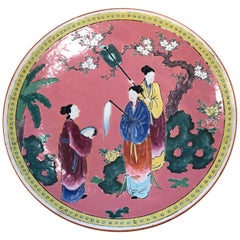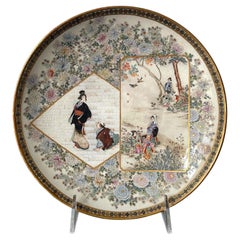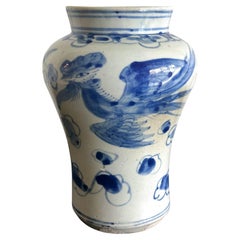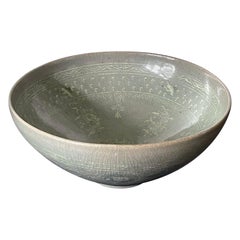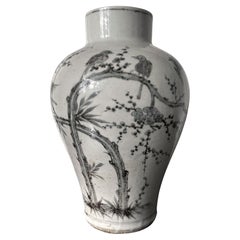Georgia - Ceramics
to
25
316
1,986
1,348
293
23
41
1
1
117
92
84
23
38
12
17
12
2
1
2
2
2
313
73
11
10
7
288
277
125
76
76
316
316
316
27
11
10
3
3
Item Ships From: Georgia
Antique Large Korean Ceramic White Bowl Joseon Dynasty
Located in Atlanta, GA
A Korean ceramic porcelain bowl covered in a white glaze with a hint of bluish green circa 18th century, possibly earlier, of the Joseon Dynasty. The deep bowl is relatively large in...
Category
18th Century Korean Archaistic Antique Georgia - Ceramics
Materials
Ceramic
Japanese Porcelain Plate
Located in Atlanta, GA
An Japanese porcelain plate circa 1930s-1940s. Decorated with over glaze featuring three ladies in waiting. In the garden, the rock grottoes, a cherry tree in blossom, a half hidden banana tree and a few peeking peonies, suggest a subtropical scenery. The ladies were pictured as holding various item, a fly...
Category
Early 20th Century Japanese Japonisme Georgia - Ceramics
Materials
Ceramic
$1,000
Japanese Satsuma Ceramic Dish with Fine Decoration by Kinkozan
By Kinkozan
Located in Atlanta, GA
A satsuma ceramic dish made by Kinkozan studio circa 1980-1900s in the late Meiji Period. The dish with a thick robust wall is supported by a large ring base and features finely deta...
Category
Late 19th Century Japanese Meiji Antique Georgia - Ceramics
Materials
Ceramic
Antique Korean Porcelain Jar with Pheonix Design Joseon Dynasty
Located in Atlanta, GA
A korean white porcelain jar with underglaze blue paint circa late 19th century toward the end of Joseon Dynasty. Porcelain jars of this elongated form with swell shoulder, wide mout...
Category
Late 19th Century Other Antique Georgia - Ceramics
Materials
Porcelain
Korean Ceramic Celadon Bowl with Slip Inlay Goryeo Dynasty
Located in Atlanta, GA
A superb Korean celadon bowl with elaborate slip inlays circa 12th century from the Goryeo Dynasties (918 to 1392AD). Despite inspired originally b...
Category
15th Century and Earlier Korean Archaistic Antique Georgia - Ceramics
Materials
Ceramic
Large Korean Ceramic Jar Joseon Dynasty
Located in Atlanta, GA
A large Korean white porcelain jar with underglaze decoration circa late 19th century of Joseon Dynasty. The vase has a well-proportioned profile of a classic jar (known as Hangari in Korean and was being produced since 18th century from Punwon-ri Kilns) with a tall upright neck that extends to a generous opening and swelled rounded shoulder that tapers down toward the base. Many of these porcelain jars were decorated with underglaze cobalt blue painting...
Category
19th Century Korean Other Antique Georgia - Ceramics
Materials
Ceramic
Korean Pottery Funerary Urn Unified Silla
Located in Atlanta, GA
A terracotta pottery funerary urn with lid from Korea Unified Silla Period, circa 9th century. The jar was in a classic globular form with raised shoulder. Although the surface was u...
Category
15th Century and Earlier Korean Other Antique Georgia - Ceramics
Materials
Ceramic
Collection of Four Chinese Ceramic Vases with Peachbloom Glaze
Located in Atlanta, GA
An American Midwest collection of four small Chinese ceramic vases covered in peach-bloom glaze circa Qing Dynasty, 19th century, possibly earlier. The set consists of three vases of...
Category
19th Century Chinese Qing Antique Georgia - Ceramics
Materials
Ceramic
Fine Japanese Enameled Satsuma Vase by Kinkozan Meiji Period
By Kinkozan
Located in Atlanta, GA
A ceramic satsuma ware vase with very fine surface decoration made by Kinkozan circa 1880-1900s of late Meiji Period. The vase is of an elegant and relatively rare form with a trumpet shape body and the so-called garlic neck and opening. The surface is exquisitely decorated in a floral scheme with gilt and a light jewel-tone enamel. The top part showcases large bundles of wisteria blossom in white and purple, cascading down from a gilt wood trellis...
Category
1880s Japanese Meiji Antique Georgia - Ceramics
Materials
Ceramic
Spode “Tabacco Leaf” Punch Bowl after Chinese Export Design, England, ca. 1820
By B. Spode
Located in Atlanta, GA
Spode “Tabacco Leaf” Punch bowl after Chinese Export design, England ca. 1820.
Category
Early 19th Century English Chinese Export Antique Georgia - Ceramics
Materials
Porcelain
Antique Korean Ceramic Buncheong Bowl Joseon Dynasty
Located in Atlanta, GA
A Korean ceramic bowl supported on a short ring foot in the classic Buncheong (or Punch'ong) style from early Joseon Dynasty circa 15th century. The bow...
Category
15th Century and Earlier Korean Archaistic Antique Georgia - Ceramics
Materials
Ceramic
Antique Korean Porcelain Peony Jar Joseon Dynasty
Located in Atlanta, GA
A Korean white porcelain jar with underglaze blue painting of large peonies with leaves circa second half of 19th century, Joseon Dynasty. Considered associated with Punwon-ri kilns ...
Category
Late 19th Century Korean Other Antique Georgia - Ceramics
Materials
Porcelain
Rare and Large Japanese Porcelain Vase Makuzu Kozan
By Makuzu Kozan
Located in Atlanta, GA
A striking blue and white vase from the studio of Japanese Potter Makuzu Kozan, also known as Miyagawa Kozan (1842–1916), one of the most established and collected ceramist from Meiji Period. Born as Miyagawa Toranosuke, Kozan established his pottery studio in Yokohama around 1870s and later became one of the appointed artist to the Japanese Imperial household. His work was exhibited in many international fairs that the Meiji government participated at the turn of the century and won many grand prizes.
With an impressively large size, this vase was likely made and reserved as a presentation piece for one of the many expositions the studio participated in the early 20th century. It was decorated with underglaze cobalt blue using the novel technique developed by Kozan called Fuki-e (the blow painting), in order to achieve the striking dimensional literary landscape known as "Mountain and Water". Being one of the most creative ceramists, Kozan started experimenting with new chemical colors from the West in the format of his porcelain glaze around 1880s. New colors allowed him to create underglaze designs that appeared bright, smooth and glossy. He even invented his own receipt of cobalt blue to achieve a much brighter yet softer shade, as evident on this vase. To create landscape that is realistic and dimensional, more common in the western paintings, he was inspired by the native Japanese ink painting technique developed around 1900 by Yokoyama Taikan...
Category
Early 20th Century Japanese Japonisme Georgia - Ceramics
Materials
Porcelain
Korean Ceramic Ido Tea Bowl Chawan Joseon Dynasty
Located in Atlanta, GA
A ceramic stoneware chawan tea bowl made in Korea circa 16-17th century. The chawan is identified as Ko-ido (small ido) due to its size and form. Ido bowls were made since 15th centu...
Category
17th Century Korean Other Antique Georgia - Ceramics
Materials
Ceramic
Large Japanese Ceramic Vase by Makuzu Kozan Meiji Period
By Makuzu Kozan
Located in Atlanta, GA
A large Japanese ceramic vase by the celebrated Meiji imperial potter Makuzu Kozan (1842-1916) circa 1880-1890s. Dated to his underglaze phase post 1887 after he successfully mastered the new colors available from the west and used them to the best advantage in his work deeply rooted in Japanese aesthetics. The vase has an impressive size and was potted in the classic baluster form with an elegant proportion. The surface is decorated using a combination of techniques of low relief sculpturing...
Category
Late 19th Century Japanese Meiji Antique Georgia - Ceramics
Materials
Ceramic
Antique Korean Buncheong Ceramic Vase with Incised Designs
Located in Atlanta, GA
A Korean ceramic bottle form jar of Buncheong ware circa 15-16th century Joseon Dynasty. The surface of the jar features a celadon glaze and an elaborate incised design of large flor...
Category
16th Century Korean Archaistic Antique Georgia - Ceramics
Materials
Ceramic
Islamic Glazed Pottery Bowl with Kufic Calligraphy Nishapur Ware Provenance
Located in Atlanta, GA
An earthenware pottery bowl in conical shape supported by a short foot ring covered in white slip and decorated with black slip paint of calligraphy in Kufic script. This type of bowl is identified as Nishapur ware circa 10-11th century (in nowadays Iran). It was made either in Samanid Dynasty (819–999) or the successive Ghaznavid Empire (977–1186) before the Mongol invasion. The white glaze on the vessel's exterior was thinly applied, resulting in areas with streaks of opaque yellowing. The black slip paint was used to decorate the bowl in flowing Kufic script before a transparent top glaze was applied. The writing, consisting of cursive strokes in bell shape, is likely an Arabic Maxim.
Under UV examination, the bowl shows some professionally restoration as described in condition. It comes with a custom-made acrylic stand as shown.
Provenance: From an American collection, thereby descent. Purchased from Yacobs Gallery, London England, July 1998. Two digital copy the original hand-written documents...
Category
15th Century and Earlier Persian Islamic Antique Georgia - Ceramics
Materials
Ceramic
Early Porcelain Underglaze Dragon Ewer by Makuzu Kozan Meiji Period
By Makuzu Kozan
Located in Atlanta, GA
A porcelain ewer with fine underglaze iron red, brown and blue decoration made by the legendary Japanese imperial potter Makuzu Kozan (1842-1916), this relatively rare piece is dated to circa Meiji 23rd to 26th year (1890-1893) based on the mark used on the base. This is the starting period when the artists departed from his high-relief and gold gilt period and started focusing on making porcelain pieces with underglaze paint and experimented new colors. The ewer form is also relatively rare in the artist's survived repertoire compared to other forms.
The piece takes its shape from the prototype Chinese...
Category
1890s Japanese Meiji Antique Georgia - Ceramics
Materials
Ceramic
19th century Rose Medallion Chinese Export Covered Chamber Bowl
Located in Savannah, GA
Rare early Canton Chinese Export porcelain Rose Medallion bowl with lid. Features include outstanding intricately painted birds, flower...
Category
Early 1800s Chinese Chinese Export Antique Georgia - Ceramics
Materials
Porcelain
Large Chinese Export Punch Bowl in Mandarin Palette & Gilt Accents, ca. 1780
Located in Atlanta, GA
Large Chinese Export punch bowl in Mandarin Palette & Gilt Accents, ca. 1780.
Category
Late 18th Century Chinese Chinese Export Antique Georgia - Ceramics
Materials
Porcelain
18th Century Chinese Export Famille Rose Tureen with Lid & Underplate
Located in Atlanta, GA
18th century Chinese Export Famille rose tureen with lid & underplate.
Category
18th Century Chinese Chinese Export Antique Georgia - Ceramics
Materials
Porcelain
Antique Korean Ceramic Buncheong Bowl Joseon Dynasty
Located in Atlanta, GA
A Korean ceramic shallow bowl on ring foot in the classic Buncheong (or Punch'ong) style from early Joseon Dynasty circa 15th century. The bowl features...
Category
15th Century and Earlier Korean Archaistic Antique Georgia - Ceramics
Materials
Ceramic
Antique Korean Mishma Tea Bowl Chawan Joseon Dynasty
Located in Atlanta, GA
A Korean Hori-Mishima Chawan (tea bowl) circa 16th-17th century (Joseon Dynasty). The tea bowl is of an upright conical form supported by a high foot ring. It was decorated with incised brushwood fence patterns filled with white slip on both the interior and exterior surface. These dominant motifs were spaced by three encircling double lines. Seven chrysanthemum flowers (inka) were stamped on the lower interior surrounding a swirling tea well on the bottom. There are six spur marks known as Meato in Japanese on the interior bottom and a pointy spot in the center of the foot ring known as Tokin. Two crack lines were historically repaired by superb Kintsugi, adding a mysterious wabi-sabi appeal to the piece.
The Hori-Mishima bowl was also known as Gohon Mishima. It was made in Bushan Kilns of the Southern Gyeongsang Province specifically for the Japanese market in the 16th-17th century, when the tea ceremonies in Japan demanded such ware. The bowl comes with a purple fabric pouch...
Category
17th Century Korean Other Antique Georgia - Ceramics
Materials
Ceramic
Antique Japanese Shino Ware Chawan Tea Bowl
Located in Atlanta, GA
On offer is a Japanese ceramic tea bowl (chawan) used in the traditional chado ceremony. The bowl was potted in clog form with a ring foot shaved extremely low. Its size and harmonious proportion make it perfect to be held in both hands during chado. Classified as shino ware...
Category
18th Century Japanese Edo Antique Georgia - Ceramics
Materials
Ceramic
Iznik Qajar Style Ceramic Tiles - set of 3
Located in Savannah, GA
A set of three Iznik Qajar style ceramic tiles.
largest: 5 ½ by 9 ½ inches
smaller: 8 inches tall
Category
Mid-20th Century Persian Georgia - Ceramics
Materials
Ceramic
$1,200 / set
Japanese Gohon Glazed Tea Bowl Chawan Meiji Period Ex-Musuem
Located in Atlanta, GA
A Japanese ceramic Gohon tea bowl (Chawan) with a slightly irregular wall circa 18th century of Meiji Period. Supported by a high notched foot ring that was left unglazed, the chawan...
Category
18th Century Japanese Meiji Antique Georgia - Ceramics
Materials
Ceramic
Japanese Glazed and Caved Ceramic Dragon Bowl by Makuzu Kozan
By Makuzu Kozan
Located in Atlanta, GA
A ceramic bowl by Japanese Imperial potter Makuzu Kozan (1842-1916) circa 1891 of late Meiji period. A very fine example of the artist's work that belongs to the middle period of his...
Category
Late 19th Century Japanese Meiji Antique Georgia - Ceramics
Materials
Ceramic
Ming Dynasty Vase with Vibrant Turquoise Glaze
Located in Atlanta, GA
Ming Dynasty (16th century) pottery vase with vivid turquoise glaze, decorated with dragons. The vase is partially moulded, with circular bosses around the mouth rim and a hexagonal ...
Category
16th Century Chinese Antique Georgia - Ceramics
Materials
Pottery
$850 Sale Price
42% Off
Famille Rose Jardiniere, Late Qing
Located in Savannah, GA
A famille rose jardiniere, late Qing Dynasty.
8 inches wide and deep by 6 inches tall
Category
Early 20th Century Chinese Qing Georgia - Ceramics
Materials
Ceramic
Large Japanese Satsuma Ceramic Vase Kinkozan
By Kinkozan
Located in Atlanta, GA
A large Japanese ceramic vase from the end of Meiji period circa 1890-1910s by Kinkozan (1645-1927). One of the largest studio manufacturers of the export ceramics at the time based in Kyoto. In the typical style of satsuma made at the turn of 20th century, the vase is elaborately decorated with a rather unusual kinran-de (gold paint) and green enamel highlight on a mottled brown background. The painterly decoration depicts a large seasonal floral arrangement in a circular fashion. Besides the obviously superb craftsmanship, what sets this particular vase apart from many lower quality and mass-produced pieces is its tone-on-tone color pallet that is visually somber and the small and sensitive details that heralds the change of the seasons. When the viewer goes beyond the first casual glimpse of the blossom and foliage, one would notice that on the edges of certain leaves as well as along the stalks, there accumulates a very thin layer of the white dust that represents the frost. The flower in bloom are chrysanthemums. Despite of being splendid, they are the messengers of the autumn. The large lotus leaf was subtly rendered in a bended and slightly withered manner, just past its prime. Although the lotus is still in bloom, the prominent seed pod indicates it may be the last for the season. The sentimental capture of the change of the seasons is not unusual in Japanese art. This vase poetically represents such a subtle transition from summer to fall, perhaps depicting the very first frost.
The neck of the vase is also slightly unusual with two rolled rings...
Category
Early 20th Century Japanese Meiji Georgia - Ceramics
Materials
Ceramic
Chinese Terracotta Tomb Figure East Han Dynasty
Located in Atlanta, GA
A small Chinese terracotta tomb figure (Ni Yong) from East Han dynasty (25-220 AD), likely from the area of nowadays Sichuan. It depicts a sitting male wit...
Category
15th Century and Earlier Chinese Han Antique Georgia - Ceramics
Materials
Terracotta
Large Ceramic Bowl Toshiko Takaezu
By Toshiko Takaezu
Located in Atlanta, GA
A large ceramic bowl by Japanese American artist Toshiko Takaezu (American, 1922 - 2011). The deep form bowl features a robust body of thick wall, s...
Category
Late 20th Century American Modern Georgia - Ceramics
Materials
Ceramic
Antique Korean Porcelain Peony Jar Joseon Dynasty
Located in Atlanta, GA
A Korean white porcelain jar with underglaze blue painting of large peonies with leaves circa second half of 19th century, Joseon Dynasty. Considered associated with Punwon-ri kilns ...
Category
Late 19th Century Korean Other Antique Georgia - Ceramics
Materials
Porcelain
Set of Two Antique Japanese Ceramic Ko-Seto Chaires
Located in Atlanta, GA
A collection of two ceramic chaires (Tea caddies) of Ko-seto ware type from Edo period Japan circa 17-18th century. This type of small jar was made of stoneware in old Seto kilns in ...
Category
18th Century Japanese Edo Antique Georgia - Ceramics
Materials
Ceramic
Japanese Glazed Stoneware Bowl by Kitaoji Rosanjin Ex-Musuem Collection
By Rosanjin Kitaoji
Located in Atlanta, GA
A stoneware round bowl with dramatic glaze made by Kitaoji Rosanjin (1883-1959) circa first half of the 20th century. The low height bowl with wide opening and swell body resembles a...
Category
Mid-20th Century Japanese Modern Georgia - Ceramics
Materials
Ceramic
Japanese Ceramic Bowl with Crescent Mark by Kodai-ji Kiln Meiji Period Ex-Musuem
Located in Atlanta, GA
An unusually shaped ceramic chawan made by Kodai-ji Kiln in Kyoto circa 19th century of Meiji Period. The bowl has a rounded shape of a monk's alms bowl supported by a short foot rin...
Category
19th Century Japanese Meiji Antique Georgia - Ceramics
Materials
Ceramic
Antique Korean White and Blue Porcelain Jar with Dragon Joseon Dynasty
Located in Atlanta, GA
A Korean white porcelain jar with underglaze blue paint circa the second half of 19th century. Porcelain jars of this elongated form with swell shoulder, wide and slightly everted mo...
Category
19th Century Korean Other Antique Georgia - Ceramics
Materials
Porcelain
Fine Japanese Ceramic Satsuma Vase by Kinkozan
By Kinkozan
Located in Atlanta, GA
A miniature Japanese ceramic vase from the end of Meiji period circa 1880s- 1910s by Kinkozan (1645-1927). One of the largest studio manufacturers of the export ceramics at the time ...
Category
Early 20th Century Japanese Meiji Georgia - Ceramics
Materials
Ceramic
Early Ceramic Vase with Unique Glaze Pattern by Brother Thomas Bezanson
By Brother Thomas Bezanson
Located in Atlanta, GA
An early ceramic vase in a pear shape form by celebrated potter Brother Thomas Bezanson (1929-2007). The shape of this porcelain glazed vase is one of the Chinese prototypes known as...
Category
Mid-20th Century American Modern Georgia - Ceramics
Materials
Ceramic
Japanese Satsuma Ceramic Ewer Yabu Meizan
By Yabu Meizan
Located in Atlanta, GA
A Satsuma ware miniature ewer from the studio of Yabu Meizan (birth name Yabu Masashichi; 1853-1934), who was one of the most celebrated and collectible Satsuma artists from the Meij...
Category
Early 20th Century Japanese Japonisme Georgia - Ceramics
Materials
Ceramic
Korean Ceramic Faceted Blue and White Bottle Vase Joseon Dynasty
Located in Atlanta, GA
A Korean blue and white long neck vase in bottle form with octagonal faceted surface from Joseon Dynasty (19th century). The elegant vase is cove...
Category
19th Century Korean Archaistic Antique Georgia - Ceramics
Materials
Ceramic
Late 19th Century Asian Porcelain Cachepot with Floating Cartouches Décor
Located in Atlanta, GA
An Asian porcelain cachepot from the late 19th century, with floating cartouches and blue, white and orange tones. Created in Asia during the later years of the 19th century, this sm...
Category
Late 19th Century Asian Antique Georgia - Ceramics
Materials
Porcelain
Pair of Large "Leaping Boy" Plates from the Nanking Cargo Shipwreck
Located in Atlanta, GA
A pair of large blue and white Qing Dynasty plates recovered from the Nanking Cargo. A large cache of porcelain and other merchandise was discovered...
Category
1750s Chinese Antique Georgia - Ceramics
Materials
Porcelain
Large Ceramic Vase by Brother Thomas Bezanson
By Brother Thomas Bezanson
Located in Atlanta, GA
An impressively large ceramic vase with a bulbous body and a long coiled neck by potter Brother Thomas Bezanson (1929-2007). The minimalist modern form might be distilled from the classic Chinese garlic bottle. The high glossy surface displays a splendid shades of dark purple, copper red, auberge and blue, in a copper flambé pattern called "peacock" glaze that was clearly inspired by ancient Jun Kiln...
Category
Late 20th Century American Modern Georgia - Ceramics
Materials
Ceramic
Korean Celadon Inlay Vase Goryeo Dynasty
Located in Atlanta, GA
On offer is an antique Korean ceramic vase from the end of Goryeo to the beginning of Joseon period (circa 14-15th). The vase features celadon crackled glaze with underglaze inlay design in black and white. The vase was a transitional piece made toward the end of Goryeo to the beginning of Joseon Yi dynasty...
Category
15th Century and Earlier Korean Archaistic Antique Georgia - Ceramics
Materials
Ceramic
Korean Ceramic White Porcelain Water Dropper Joseon Dynasty
Located in Atlanta, GA
A small Korean water dropper in rectangular form with beveled edges, circa early 19th century of the Joseon Dynasty. The milky white porcelain pie...
Category
19th Century Korean Other Antique Georgia - Ceramics
Materials
Ceramic
Fine Trumpet Satsuma Vase by Taizan Yohei
Located in Atlanta, GA
A tall ceramic satsuma ware vase in a rare slender trumpet form with very fine surface decoration by Japanese potter Taizan Yohei IX (1864-1922). The vase was dated to late Meiji period circa 1890-1900s.
The main motif and the focal point of the vase is the continuous panel that circumvents the entire mid-body, apparently a rendition of the Boy's Festival, known as "Tango no Sekku" in Japanese. The traditional festival is celebrated on May 5th of each year. Originated in Nara Period...
Category
1880s Japanese Meiji Antique Georgia - Ceramics
Materials
Ceramic
Antique Korean Ceramic Gohon Chawan Tea Bowl Joseon Dynasty
Located in Atlanta, GA
A ceramic chawan (tea bowl) circa 17-18th century fired in the Busan kiln in Southern Korean specifically for the Japanese market. The kilns were contro...
Category
17th Century Japanese Edo Antique Georgia - Ceramics
Materials
Ceramic
Japanese Glazed Mino Tea Bowl Chawan Showa Period Ex-Musuem
Located in Atlanta, GA
A Japanese glazed ceramic tea bowl (chawan) in Gohon style likely made in Showa period of 20th century. Supported by a short foot ring with a notch, the bowl was made from coarse cla...
Category
Early 20th Century Japanese Meiji Georgia - Ceramics
Materials
Ceramic
Early Large Ceramic Vase with Sang-de-boeuf Glaze by Brother Thomas Bezanson
By Brother Thomas Bezanson
Located in Atlanta, GA
An early ceramic long-neck vase with a brilliant copper red glaze by Benedictine monk potter Brother Thomas Bezanson (1929-2007). The minimalistic an...
Category
1960s American Modern Vintage Georgia - Ceramics
Materials
Ceramic
Large Antique Chinese Sang-de-Boeuf LangYao Red Vase
Located in Atlanta, GA
A large Chinese vase with Sang-de-Boeuf (oxblood) glaze in a classic baluster form with a tall narrow neck and horizontal bands around the shoulder. The oxblood glaze is known as Lan...
Category
Late 19th Century Chinese Chinese Export Antique Georgia - Ceramics
Materials
Ceramic
Modern Japanese Studio Pottery Oribe Moon Flask Vase by Ken Matsuzaki
By Ken Matsuzaki
Located in Atlanta, GA
A contemporary studio ceramic vase made by Japanese potter Ken Matsuzaki (1950-). The vase showcases distinguished "moon flask" form with shoulder loops. The moon flask form was widely recorded first in Tang Dynasty China, most likely arrived from the Mideast countries via the silk road. It was originally used as drink vessel for the nomads and the loops were used to tie it to the horse-centered owner. The exotic form persisted in Chinese ceramic production through Ming to Qing dynasty. The form is unusual in Ken Matsuzaki's work. The artist covered the vase with a thick dripping Oribe green glaze partially revealing the unglazed part of the body, which is decorated with scrolling pattern in left by ash glaze. The work is rooted in both Yohen Shino glaze technique and Oribe tradition, but interestingly it also paid homage to Sancai pottery in Tang Dynasty when green glaze was prominently used to drip and splash onto the pottery. Viewing the vase, one can see in this harmonious piece, the innovative reinterpretation of ancient aesthetics that cross the cultures, geology and time. The base is marked with the artist's signature. The vase comes with an inscribed tomobako storage box with the artist's bio and wrapping cloth with seal. The vase measures 8.6"h x 7"w x 2"d.
Ken Matsuzaki’s haptic ceramics bring a contemporary approach to traditional Japanese ceramicware, most notably 16th-century Oribe pottery...
Category
Early 2000s Japanese Modern Georgia - Ceramics
Materials
Ceramic
Antique Chinese Ceramic Tea Leaf Storage Jar Song-Yuan Dynasty
Located in Atlanta, GA
A stoneware pottery jar used for storage, made in southern China Fujian or Guangdong province since Song Dynasty for domestic use as well as export. They were widely exported to Japa...
Category
15th Century and Earlier Chinese Archaistic Antique Georgia - Ceramics
Materials
Ceramic
Korean Reticulated Celadon Brush Holder Joseon Dynasty
Located in Atlanta, GA
A Korean porcelain brush holder in cylinder log form from the end of Joseon dynasty circa late 19th century. Cherished by the scholars, brush pot like this would grace the desk in th...
Category
Late 19th Century Korean Other Antique Georgia - Ceramics
Materials
Ceramic
Rare Korean Ceramic Brush Holder Joseon Dynasty
Located in Atlanta, GA
A rare Korean porcelain brush holder in Banana Leaves pattern from late Joseon dynasty circa 19th century. Cherished by the scholars, this brush...
Category
19th Century Korean Other Antique Georgia - Ceramics
Materials
Ceramic
Ceramic Vase with Bespoken Glaze by Makoto Yabe
By Makoto Yabe
Located in Atlanta, GA
Made by Japanese ceramic artist Makoto Yabe (1947-2005), this stoneware vase features a globular body supported by a round pedestal foot. A similarly shaped neck extends to a rimmed mouth opening. Robust in form with thick wall, the vase is noted for its irregular cloved form. The surface is covered in a beige-yellow glaze, on top of which, dark brown strokes and thick white feldspar slip were artistically applied in a splashed and washed pattern. Together with some random shallow incision lines, they form an abstract painting with textured surface where some slip forms small droplets at the end of the stroke. The work was created in traditional Japanese manner and reflects the beauty of Wabi Sabi, a Zen aesthetic for the imperfect perfection.
The base was incised with the artist's cipher.
"Makoto Yabe's work beautifully exemplifies the transmission of Japanese ceramics to the West. Born in Fukushima, Japan, Yabe began studying ceramics in Kyoto at the age of nine. He completed his training at the age of 24, with a four-year apprenticeship under Jinmatsu Uno and Sango Uno. Yabe then came to Boston, where he was an integral member of the local ceramic community, yet he maintained his Japanese roots. As an instructor of ceramics, Yabe worked in the Boston area at numerous schools and universities, touching the lives of all his students and expanding their knowledge and appreciation of studio ceramics."
Biography sited from Pucker Gallery...
Category
Late 20th Century American Organic Modern Georgia - Ceramics
Materials
Ceramic, Stoneware
Two Islamic Nishapur Glazed Pottery Bowls
Located in Atlanta, GA
A collection of two small pottery bowls with polychrome central figurative decorations, matching size and similar conical form. These bowls are identified as Nishapur ware circa 10th century (in nowadays Iran). They were stoneware (possibly buffware) and covered with opaque white glaze. Both were lovely decorated with a central human figure within an outer border. One is predominantly yellow, an imitation of luster ware...
Category
15th Century and Earlier Persian Islamic Antique Georgia - Ceramics
Materials
Ceramic
$3,600 / item
Korean Ceramic Storage Jar Joseon Dynasty
Located in Atlanta, GA
A Korean ceramic storage jar circa 18th century of Joseon Dynasty. The jar is of a characteristic form with a bulbous upper body that tappers with a gra...
Category
18th Century Korean Other Antique Georgia - Ceramics
Materials
Ceramic
Korean Ceramic Tea Bowl with Slip Inlays Goryeo Dynasty
Located in Atlanta, GA
A small ceramic conical form tea bowl from Korean Goryeo Dynasty circa 14th century. The bowl is of a slightly irregular shape and covered in a grayish overglaze. The inlaid slip dec...
Category
15th Century and Earlier Korean Archaistic Antique Georgia - Ceramics
Materials
Ceramic
Antique Korean Celadon Bottle Vase Joseon Dynasty
Located in Atlanta, GA
A Korean ceramic bottle-form vase circa 16th century Joseon Dynasty. It was likely intended as a wine bottle, the pear-shaped vessel with flaring neck feature a celadon glaze exterio...
Category
16th Century Korean Archaistic Antique Georgia - Ceramics
Materials
Ceramic
Recently Viewed
View AllMore Ways To Browse
Mashiko Pottery
Japanese Imari Box
Nabeshima Porcelain
Nanking Porcelain
Japanese Ceramic Sake Bottle
Japanese Kutani Early 20th Century
Oribe Ceramics
Porcelain Japanese Statues
Hirado Porcelain
Japanese Bizen Ware Pottery
Japanese Kutani Figure
Ko Kutani
Kutani Figure
Large Asian Floor Vases
Hatcher Cargo
Korea Tea Bowl
Kutani Charger
Red Chinese Foo Dogs
